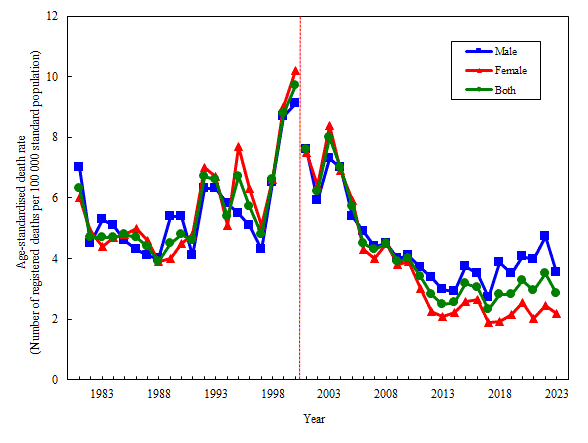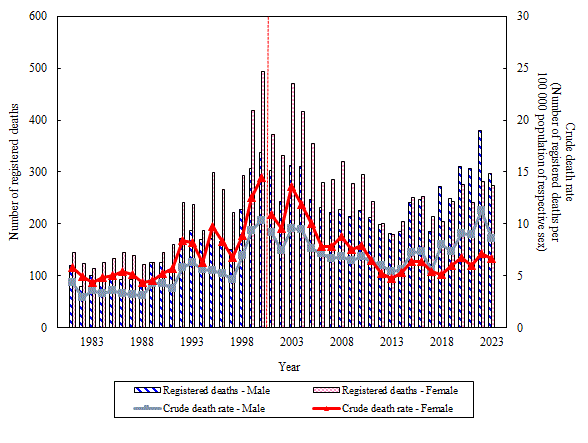Diabetes Mellitus
Introduction
Insulin is a hormone that is released from the pancreas to facilitate the storage of glucose as glycogen and triglyceride in the body. Diabetes mellitus (DM) is a chronic disorder characterised by a raised blood glucose level resulting from insulin deficiency, insulin resistance or both. In Type I or insulin-dependent diabetes mellitus (IDDM), little or no insulin is produced. In Type II or non-insulin-dependent diabetes mellitus (NIDDM), there is reduced insulin secretion and the body cells do not react to insulin. Diabetes mellitus increases the risk of cerebrovascular disease, heart diseases, foot gangrene, retinopathy, nephropathy and neuropathy.
Situation in Hong Kong
Classification of diseases and causes of death is based on the International Statistical Classification of Diseases and Related Health Problems (ICD) 10th Revision from 2001 onwards. Figures from 2001 onwards may not be comparable with figures for previous years which were compiled based on the ICD 9th Revision.
Diabetes mellitus corresponds to codes 250 in ICD-9 and E10-E14 in ICD-10.
DM is a major cause of morbidity and mortality in Hong Kong. In 2023, it claimed about 12 000 inpatient discharges and inpatient deaths in all hospitals†, and 570 registered deaths‡. It was the eleventh commonest cause of deaths in Hong Kong, accounting for 1.0% of all registered deaths. The crude death rates of DM were 8.6 for males and 6.7 for females per 100 000 population of respective sex. The age-standardised death rates* of DM were 3.5 for males and 2.2 for females per 100 000 standard population.
According to the Population Health Survey (PHS) 2020-22 conducted by the Department of Health, the total prevalence of DM combining cases that were self-reported or detected by biochemical testing was 8.5% (6.1% for females and 11.1% for males) among persons aged 15-84, including 3.1% with no self-reported history but raised blood glucose by biochemical testing. The total prevalence of DM increased steadily with age from 0.6% among those aged 15-24 to 19.0% among those aged 65-84.
Number of registered deaths and crude death rate of diabetes mellitus by sex, 1981 to 2023 (View)
Age-standardised death rate of diabetes mellitus by sex, 1981 to 2023

| Notes: | † | Include both inpatient discharges and inpatient deaths in all hospitals with heart diseases as the principal diagnosis in that episode of hospitalisation. |
| ‡ | Include registered deaths with heart diseases as the underlying cause of death. | |
| * | Age-standardised incidence / death rates are compiled based on the world standard population specified in GPE Discussion Paper Series: No.31, EIP/GPE/EBD, World Health Organization, 2001. | |
| Data in the above charts from 1996 onwards are compiled based on the population estimates under the "resident population" approach instead of the "extended de facto" approach. | ||
| Classification of diseases and causes of death is based on the International Statistical Classification of Diseases and Related Health Problems (ICD) 10th Revision from 2001 onwards. Figures from 2001 onwards may not be comparable with figures for previous years which were compiled based on the ICD 9th Revision. | ||
| Sources: | Census and Statistics Department Department of Health |
Symptoms
People with diabetes are often asymptomatic. They can be diagnosed by checking blood glucose level during medical examination. As the disease develops, diabetes may present with symptoms or complications. Possible symptoms include thirst, excessive urination, increased appetite, weight loss, lethargy, poor wound healing and infections. Uncontrolled diabetes causes acute conditions such as severe dehydration and coma.
Risk factors
Some risk factors for diabetes include advancing age, obesity, family history of diabetes and lack of physical activity. Diabetes can also be predisposed by some endocrine diseases, pancreatic diseases and drugs e.g. steroids.
Prevention
To prevent diabetes, one should maintain an optimum body weight and waist circumference through a balanced diet, regular physical activity and refrain from alcohol consumption. Diabetic patients should have their blood sugar under control through dietary or pharmacological measures.
Related information
For more information on diabetes, please visit the website the Hong Kong Reference Framework for Diabetes Care for Adults in Primary Care Settings.

